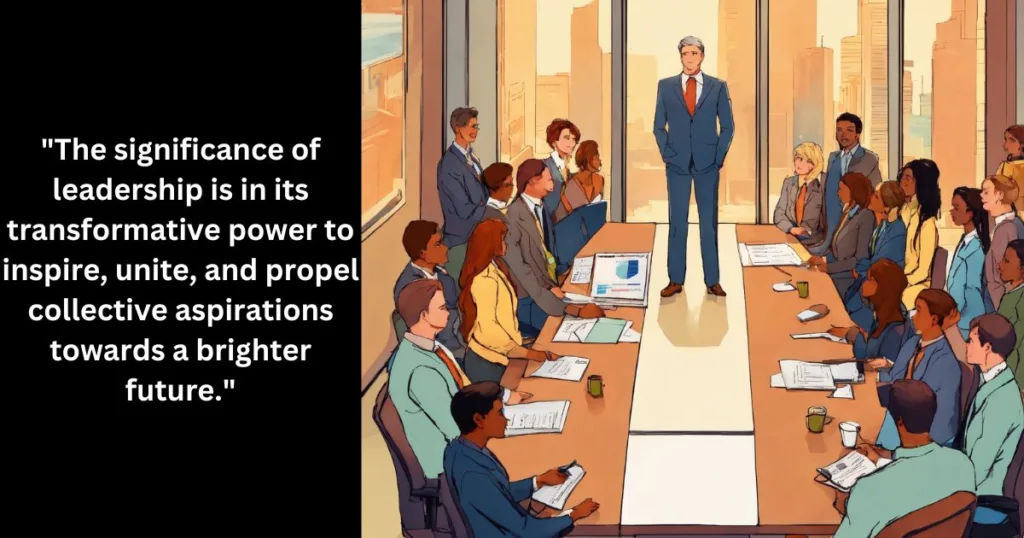Leadership is a concept that lies at the heart of team success. Why leadership matters in building great teams. A competent leader can inspire, guide, and empower individuals to achieve shared goals, resulting in exceptional team dynamics. In this blog post, we will explore the hidden power of leadership by delving into its meaning, features, role, functions, and significance. By unraveling the mysteries behind effective leadership, we can gain a deeper understanding of its impact on teams and their accomplishments.
The Essence of Leadership

Understanding the meaning of leadership beyond authority:
Leadership as a guiding force
Leadership is not merely about wielding authority or giving orders. It is a guiding force that leads teams towards a common vision and purpose. A true leader inspires and motivates others to go beyond their limits, igniting a spark within them to achieve remarkable feats.
Leadership as an art of influence
The art of leadership lies in influencing others positively. A leader possesses the ability to convince, persuade, and inspire individuals to embrace change, overcome challenges, and reach new heights. Leadership goes beyond positions of power and encompasses the capacity to make a meaningful impact on others’ lives.
Leadership as a catalyst for growth
Leadership acts as a catalyst for both personal and collective growth. A leader creates an environment that encourages individual development, learning, and innovation. By nurturing potential within their team, a leader fosters an atmosphere of continuous progress and ensures the achievement of greater goals.
Key features of effective leadership:
1. Visionary leadership that inspires:
Effective leaders have a clear vision and the ability to inspire their team members to share that vision. They articulate a compelling future and paint a vivid picture of success, igniting enthusiasm and commitment within their teams.
2. Emotional intelligence as a cornerstone:
Emotional intelligence is a vital feature of effective leadership. Leaders who possess emotional intelligence are aware of their own emotions and can empathize with and understand the emotions of others. This enables them to forge stronger connections, resolve conflicts, and create a harmonious team environment.
3. Adaptability and flexibility for changing dynamics:
In today’s dynamic world, effective leaders demonstrate adaptability and flexibility. They embrace change, adapt to evolving circumstances, and inspire their teams to respond proactively to new challenges. This flexibility allows for agility and ensures the team remains innovative and resilient.
The Role of Leadership in Inspiring Team Dynamics:
1. Building a positive team culture:
Leadership plays a pivotal role in shaping and nurturing a positive team culture. A leader creates an environment built on trust, open communication, and mutual respect. This fosters an atmosphere of collaboration, where team members feel valued, motivated, and supported.
2. Promoting collaboration and cohesion:
Leadership enhances team dynamics by promoting collaboration and cohesion among team members. A leader facilitates effective communication, encourages the sharing of ideas, and ensures that everyone is working towards a common goal. This synergy creates a powerhouse of collective knowledge and expertise, leading to higher productivity and achievement.
3. Nurturing individual and collective growth:
Effective leaders foster an environment conducive to individual and collective growth. They provide opportunities for skill development, mentorship, and training. By investing in their team members’ growth, leaders empower their teams and unlock their full potential.
Functions of Leadership:

Setting direction and goals
1. Defining a clear mission and vision:
Leadership articulates a clear mission and vision that guides the team toward its goals. By setting a sense of purpose, leaders align their team members’ efforts and channel them towards a collective objective.
2. Establishing achievable goals and objectives:
Leadership plays a crucial role in setting achievable goals and objectives. By breaking down larger goals into smaller, manageable tasks, leaders provide a roadmap for success while ensuring alignment with the team’s overall vision.
3. Communicating expectations to the team:
Effective leaders communicate expectations clearly to their team members. They ensure that everyone understands their roles, responsibilities, and the standards expected of them. This clarity fosters accountability and motivates team members to perform at their best.
Making critical decisions:
1. Analyzing options and assessing risks:
Leadership involves making critical decisions by carefully analyzing various options and assessing potential risks. Effective leaders weigh the pros and cons, gather input from team members, and consider both short-term and long-term implications.
2. Encouraging diverse perspectives and ideas:
Leadership thrives on diversity of thought. A good leader encourages team members to provide diverse perspectives and ideas. By fostering an environment where everyone feels comfortable sharing their thoughts, leaders can make informed decisions that reflect the team’s collective intelligence.
3. Taking responsibility for outcomes:
Leadership requires taking responsibility for the outcomes of decisions made. Effective leaders lead by example and are accountable for their actions, whether they result in success or failure. This accountability fosters trust and strengthens team dynamics.
Providing guidance and support:
1. Coaching and mentoring team members:
Leadership involves coaching and mentoring team members to help them achieve their full potential. Effective leaders provide guidance, support, and valuable feedback to their team members. They recognize individual strengths and weaknesses, helping team members grow both personally and professionally.
2. Offering constructive feedback and recognition:
Leadership entails offering constructive feedback and recognition. Effective leaders provide timely feedback that helps team members improve their performance. They also recognize and appreciate their team members’ accomplishments, fostering a positive and motivating work environment.
3. Empowering and developing future leaders:
Leadership focuses on empowering and developing future leaders within the team. Effective leaders invest in the growth and development of their team members, nurturing their leadership skills and paving the way for future success.
The Significance of Leadership:

Driving innovation and growth:
1. Inspiring creativity and out-of-the-box thinking:
Leadership promotes a culture of innovation by encouraging team members to think creatively and come up with new ideas. Effective leaders provide the freedom and support for team members to explore innovative solutions and think outside the box.
2. Encouraging experimentation and embracing change:
Leadership encourages experimentation and embraces change as opportunities for growth. Effective leaders create an environment where team members feel empowered to take risks, learn from failures, and adapt to changing circumstances.
3. Fostering a culture of continuous improvement:
Leadership establishes a culture of continuous improvement within the team. Effective leaders encourage reflection, embrace feedback, and drive a mindset of learning. This commitment to constant growth fuels innovation and ensures the team’s sustained success.
Enhancing team performance and productivity:
1. Motivating individuals toward shared goals:
Leadership motivates individuals towards shared goals by creating a sense of purpose and alignment. Effective leaders inspire their team members, instilling a strong work ethic, and a drive for success. This motivation leads to increased performance and productivity.
2. Improving communication and collaboration:
Leadership improves team performance by fostering effective communication and collaboration. Effective leaders facilitate open dialogue, ensure that everyone’s voice is heard, and resolve conflicts to maintain a positive and productive team environment.
3. Maximizing strengths and addressing weaknesses:
Leadership recognizes and maximizes team members’ strengths while addressing their weaknesses. Effective leaders leverage each team member’s unique capabilities, ensuring that tasks are assigned appropriately and the team collectively performs at its best.
Cultivating resilience and adapting to challenges:
1. Guiding teams through adversity and setbacks:
Leadership plays a critical role in guiding teams through adversity and setbacks. Effective leaders provide support, encouragement, and guidance during challenging times. They instill confidence, promoting an attitude of resilience that enables the team to overcome obstacles and emerge stronger.
2. Instilling confidence and managing conflicts:
Leadership instills confidence in team members by providing a clear path forward and facilitating conflict resolution. Effective leaders support their teams in navigating conflicts, finding common ground, and maintaining a harmonious work environment.
3. Embracing change and seizing opportunities:
Leadership embraces change and encourages teams to seize growth opportunities. Effective leaders inspire a culture of adaptability, enabling the team to navigate change successfully and leverage new possibilities for innovation and success.
People Also Read: Good Governance: Powerful Concept, Meaning, Features, and Relevance
Summary:
Recap of key points discussed in the article:
In this blog post, we explored the hidden power of leadership. We discussed the essence of leadership beyond authority, emphasizing its role as a guiding force, an art of influence, and a catalyst for growth. The key features of effective leadership were unraveled, highlighting visionary leadership, emotional intelligence, and adaptability.
We also delved into the role of leadership in fostering positive team dynamics, focusing on building a positive team culture, promoting collaboration and cohesion, and nurturing individual and collective growth.
Furthermore, we explored the functions of leadership, including setting direction and goals, making critical decisions, and providing guidance and support. We highlighted the significance of leadership in driving innovation and growth, enhancing team performance and productivity, and cultivating resilience and adapting to challenges.
FAQs:
1. How can leadership be developed and improved?
Leadership can be developed and improved through a combination of self-awareness, continuous learning, and practice. By seeking feedback, reflecting on experiences, and investing in personal growth, individuals can enhance their leadership skills.
2. Can anyone become a leader?
Yes, anyone can become a leader. Leadership is not solely determined by one’s position or title but rather by the ability to inspire, influence, and guide others toward a common goal. Leadership can be cultivated and developed at any stage of one’s life or career.
3. Is leadership only relevant in professional settings?
No, leadership is relevant in various aspects of life, not just in professional settings. Leadership can be applied in personal relationships, community involvement, and various other contexts where individuals have the opportunity to influence and inspire others.
Conclusion:
Uncovering the hidden power of leadership can pave the way for the success of great teams. By examining its meaning, features, role, functions, and significance, we can better understand how leadership drives positive team dynamics and fosters growth. Effective leadership not only sets direction and provides guidance but also fuels innovation, enhances performance, and cultivates resilience, making it an indispensable force in achieving collective success.










